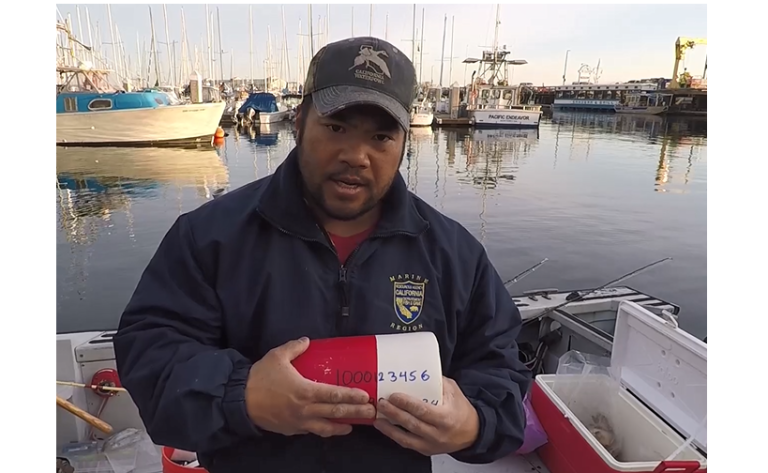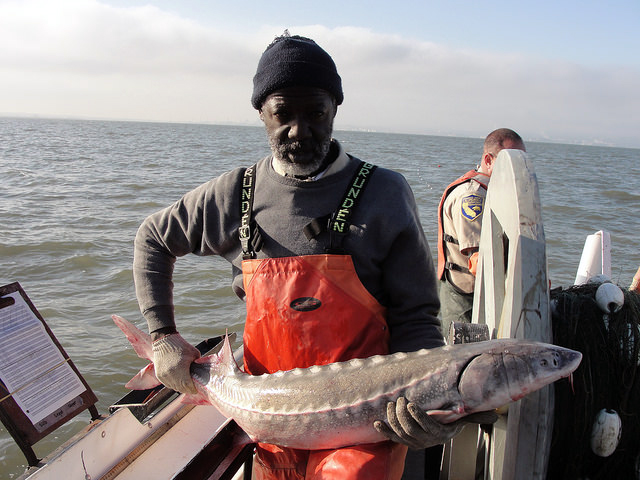Fish Report for 3-15-2018
More Than One GO ID on Crab Buoys?

by Carrie Wilson
3-15-2018
Website
Question: Is there any regulation that would prohibit multiple GO IDs on crab buoys? For instance, if a group of friends wanted to share the same crab gear, could they each place their GO IDs on the buoys? (Steve Brown)
Answer: For recreational fishing, there is no regulation prohibiting multiple GO IDs on crab trap buoys used under a sport fishing license (California Code of Regulations Title 14, section 29.80(c)(3).) The GO ID number on the buoy must match the GO ID of the operator’s sport fishing license (section 29.80(c)(3).)
If the operator is not the owner of the gear, then written permission from the owner of the trap needs to be in the operator’s possession. This includes permission transmitted by email or text (section 29.80(a)(3)).
There is an exception in section 29.85(a)(5), which requires that crab traps used on a commercial passenger fishing vessel have the commercial boat registration number on the buoy.
How many crab traps can one fisherman drop?
Question: Is there a limit of crab traps a recreational crab fishermen can drop? I personally have 19 crab pots I inherited from my grandfather and want to know if I can use all of them at one time. (Philip)
Answer: There is no limit on the number of crab traps a recreational fisherman can use unless they are on a commercial passenger fishing vessel, in which case the vessel is limited to 60 traps for taking Dungeness crab (CCR Title 14, section 29.85(a)(4)). However, it is unlawful to waste any fish (section 1.87), which includes Dungeness crab (see the definition of “fish” in Fish and Game Code, section 45). That means that you are expected to regularly check all of the traps that you use. Crabs left in traps that are not regularly checked eventually die and can attract more crabs to the trap, both of which could be considered waste of fish.
Do I need to take a boat safety course?
Question: I know there are boat safety courses. Is it required to have passed a boat safety course to legally operate a vessel on the sea to either fish or crab? (Phillip)
Answer: As of Jan. 1, 2018, the mandatory boating safety education law went into effect, and will be phased in by age. If you operate any type of motorized vessel on California waterways (including powered sailboats/paddlecraft), you will be required to pass an approved boating safety examination and carry a California Boater Card. The first group required to take the exam are boaters 20 years of age and younger. Each year after January 2018, a new age group will be added to those who are required to possess a valid card. Once issued, the card remains valid for an operator’s lifetime. The cost of the card is $10. You can apply online through the California State Parks Division of Boating and Waterways.
Crafting with Animal Hide
Question: I am trying to craft a project made out of wood that may require small amounts of fur or hide from an animal. Is it legal to buy those parts from a different state and get them shipped to California? Or would I have to try to find a store in California that sells them? (Erick)
Answer: With few exceptions, FGC, section 3039 states that “…it is unlawful to sell or purchase any bird or mammal found in the wild in California.” But products or handicrafts made from furbearing mammals and nongame mammals lawfully taken under the authority of a trapping license may be purchased or sold. Therefore, regardless of whether the seller is within the state, you should make sure that you are not purchasing any fur or hide from any animal found in the wild in California, unless you can document the fur or hide was lawfully taken by a licensed trapper. One of the exceptions is FGC, section 4303, which states: The skin or hide of any deer lawfully taken may be sold, purchased, tanned, or manufactured into articles for sale. This may be an option for you.
Be advised there are special restrictions related to bears: FGC, section 4758 states that “…it is unlawful to sell or purchase, or possess for sale, the meat, skin, hide, teeth, claws, or other parts of any bear in this state…”
Carrie Wilson is a marine environmental scientist with the California Department of Fish and Wildlife. While she cannot personally answer everyone’s questions, she will select a few to answer each week in this column. Please contact her at [email protected].
More Reports

3-15-2018
The California Department of Fish and Wildlife (CDFW) is reminding sturgeon anglers to return their 2017 Sturgeon Fishing Report Cards...... Read More

3-14-2018
California wildlife officers have uncovered what is likely the largest raptor poaching case in known California history, the California Department...... Read More

Website Hosting and Design provided by TECK.net